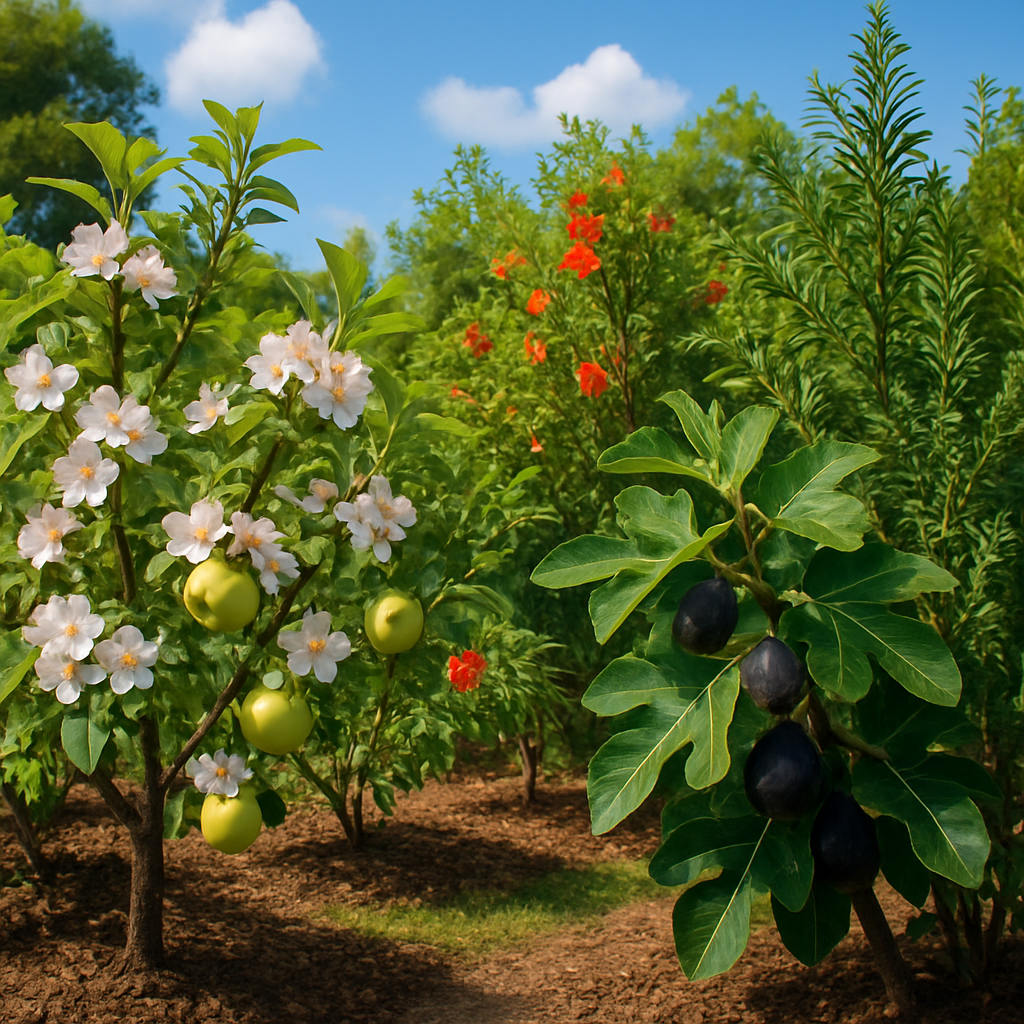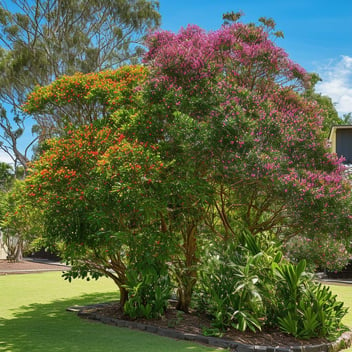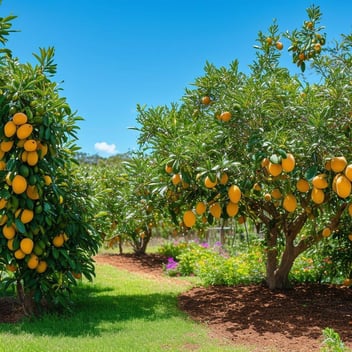Deciduous Fruit‑Bearing Trees Perfect for South East Queensland
Introduction
Deciduous fruit trees offer more than just summer bounty. They bring rhythm to the garden: blossom, fruit, leaf fall, rest. In South East Queensland, where winters are mild and summers intense, the right deciduous varieties can thrive. Plant them well, care for them faithfully, and they’ll reward you year after year.
South East Queensland’s climate lies in a sweet spot. Warm, humid summers. Mild winters. Enough cold exposure to satisfy low‑chill fruit trees. Plenty of sun. If you choose wisely, you can grow fruit that elsewhere demands cooler conditions.
Selecting Deciduous Fruit Trees for SEQ
Chill Hours & Dormancy Requirements
Deciduous fruit trees often need a certain number of “chill hours” — periods of lower temperatures during winter — to set fruit properly. In SEQ, winters may not always provide high chill hours, so selecting low‑chill cultivars is essential. Trees with minimal dormancy needs adapt better, flower reliably, and bear fruit without forced cold.
Soil, Sunlight & Microclimate Needs
Well‑drained soil is non‑negotiable. Many deciduous fruits do poorly in waterlogged root zones. Light soils amended with organic matter boost drainage, moisture retention, and nutrient supply. Full sun exposure (at least six hours daily) is generally required for good fruit production. Also consider microclimates: protect from harsh afternoon sun or strong winds; slopes, walls, or fences can moderate extremes.
Top Deciduous Fruit Trees Ideal for SEQ
Apples & Pears: Low‑Chill Cultivars
Despite being classic temperate fruits, apples and pears can succeed in SEQ if low‑chill or heat‑tolerant varieties are chosen. Cultivars bred for warm temperate zones produce dessert‑quality fruit even with fewer cool hours. Pairs of compatible pear varieties may be needed for cross‑pollination. Soil moisture and consistent nutrition help.
Stone Fruits: Peaches, Plums & Apricots
Stone fruits can be spectacular in flavour and beauty: blossoms heralding spring, juicy fruits in summer or early autumn. Select peach and nectarine cultivars bred for low chill. Plums similarly; some apricots may struggle if late frost occurs, so positioning matters. Mulching helps protect roots, models of shade help avoid sunburnt fruit.
Figs & Pomegranates
Figs are forgiving. They bear fruit well, tolerate heat, and are often semi‑deciduous in subtropical climates. Pomegranate trees too: tough, ornamental, with spectacular flowers and colourful fruit. Both are lower maintenance, less fussy about chill hours, though still needing good drainage and full sun.
Native & Unique Varieties
Incorporating native fruiting trees can bring uniqueness and ecological benefit. Species like Davidson’s Plum, Finger Lime, or other indigenous fruit trees offer flavour and heritage. Often better adapted to local pests, soils, and rainfall patterns. Even when leaf‑drop occurs, native trees usually bounce back strongly.
Planting & Establishment Practices
Timing: When To Plant for Best Results
Early autumn or late winter is often ideal. This allows roots to establish before high heat or heavy rains. Some stone fruit trees are best planted just before spring so that blossoms can develop properly. Avoid planting just before hottest weeks or storms.
Planting Technique: Soil Prep, Spacing, Support
Dig planting holes twice as wide as the root ball, same depth or slightly raised to enhance drainage. Mix in compost or well‑rotted manure. Use stakes for young trees to guard against wind damage. Space trees far enough apart so their mature canopies don’t overcrowd. Consider dwarf rootstocks if space is limited.
Care Through the Seasons
Spring Flowering & Pollination
Spring is critical: blossoms must be pollinated, which often means encouraging bees or other pollinators. Avoid heavy fertilisation just before flowering, which can lead to vigorous leafy growth at the expense of blooms. Check for frost risk (though rare in SEQ), and protect open blossoms if sudden cold snaps occur.
Summer Heat & Fruit Development
Keep soil moisture consistent during fruit set and development. Mulch deeply to retain moisture and keep roots cool. Provide shade for vulnerable young fruit or tender skins. Monitor for pests (fruit flies are active) and diseases that thrive in humid conditions.
Autumn Ripening & Leaf Fall
Autumn brings ripeness. Harvest when fruit is mature; over‑ripe fruit often attracts pests. As leaf fall begins, tidy up fallen foliage to reduce disease carry‑over. Some deciduous varieties will drop leaves earlier—be ready with garden clean‑up.
Winter Dormancy & Protection
Trees need rest. Even low‑chill trees slow growth. Fertiliser application should taper off. Protect graft unions or sensitive trunks if frost or cold snaps occur. Prune during dormancy to shape structure before new spring growth.
Pest, Disease & Maintenance Challenges
Common Pests in SEQ Fruit Trees
Fruit flies, scale insects, mites, aphids. Each can damage blossoms or fruit. Regular inspection, trap usage or biological controls help. Keeping trees healthy reduces pest pressure.
Disease Risks & Fungal Problems
Humid summers encourage fungal issues: powdery mildew, fruit rots, leaf spots. Good air circulation via pruning, avoiding overhead watering, and selecting resistant cultivars help. Treat appropriately if signs emerge; preventive fungicides may be warranted in very wet seasons.
Pruning & Thinning for Health & Yield
Prune to open up canopy, remove dead or crossing branches. Thinning—removing excess fruit—prevents overburdening limbs and improves fruit size and quality. Structural pruning early leads to stronger trees that require less corrective pruning later.
Harvesting & Using the Fruits
When Fruits Are Truly Ripe
Each species has its markers: colour, softness, scent. Apples/pairs become aromatic; stone fruit soften slightly at the stem end; figs droop and change hue; pomegranates crack or develop rich colour. Harvest at peak taste—not just appearance.
Storage, Preservation & Culinary Uses
Some fruits store well (apples, pears, pomegranates). Others are best eaten fresh. Preserving via drying, freezing, jams, preserves extends benefit. Sharing with neighbours or using surplus fruit can reduce waste.
Conclusion
Growing deciduous fruit trees in South East Queensland is not only possible—it can be deeply rewarding. Choose low‑chill or adapted varieties. Honour their seasonal needs. Care for them throughout the year.
In return, you gain flavour, beauty, shade, flavour, and seasonal rhythm. A garden that bears fruit becomes more than just ornament—it becomes an ongoing feast and annual celebration.




